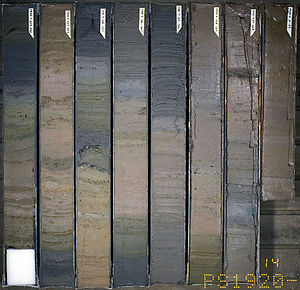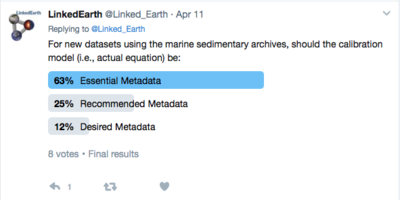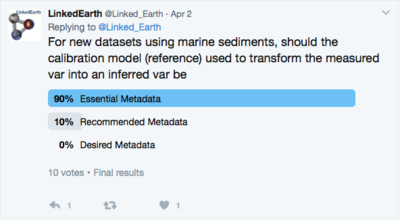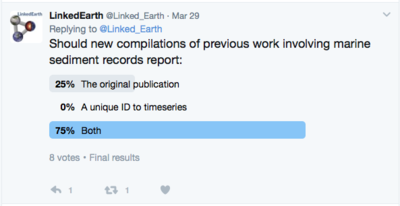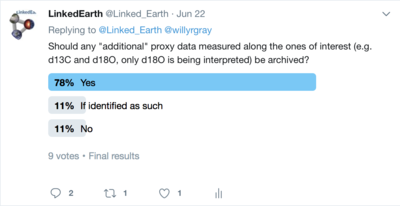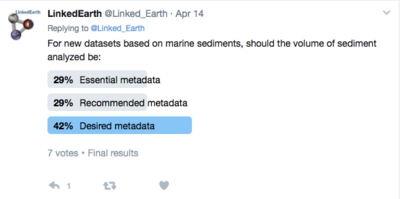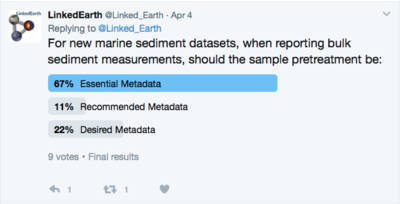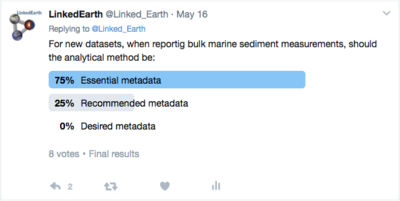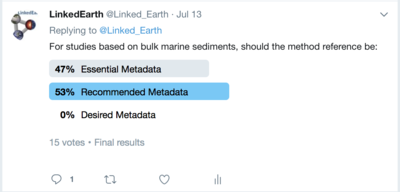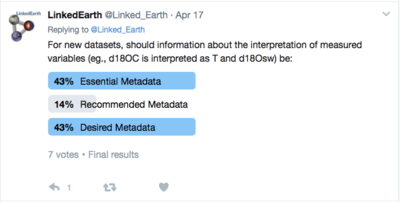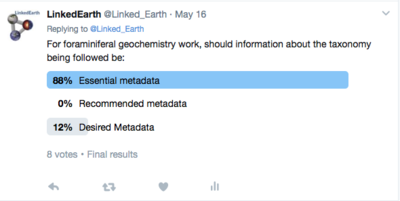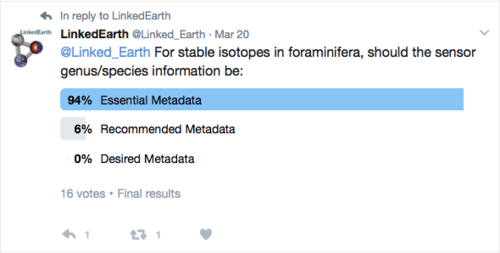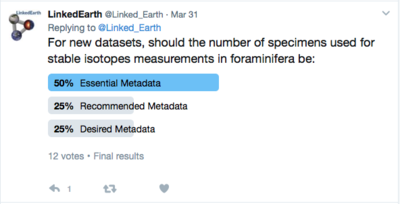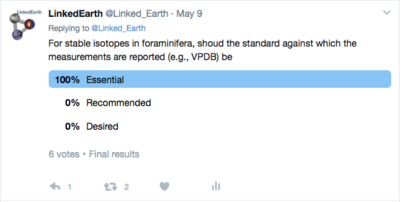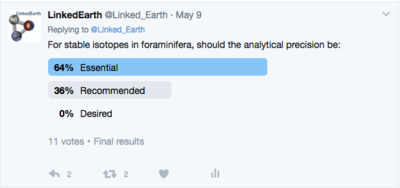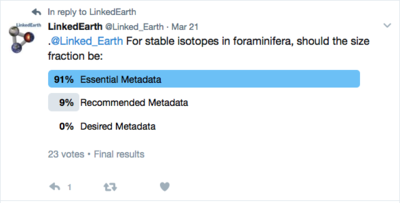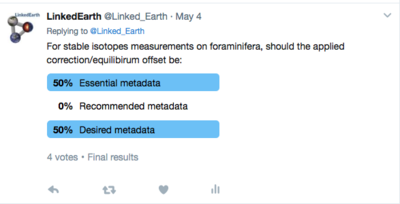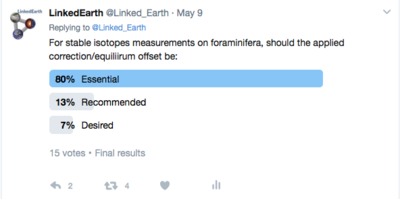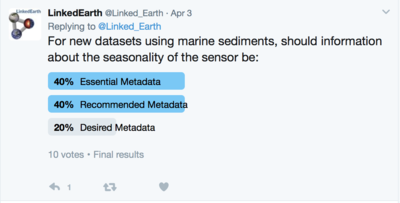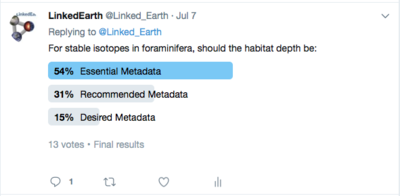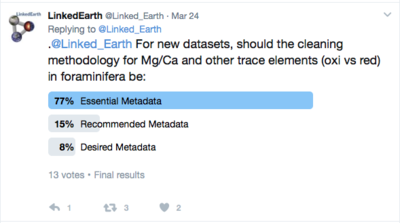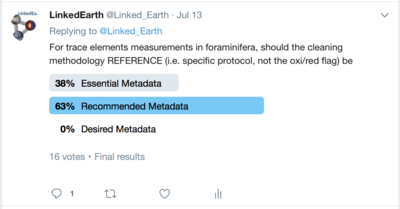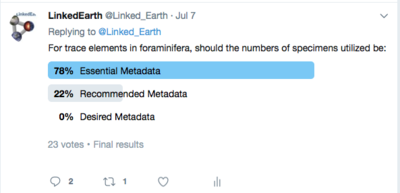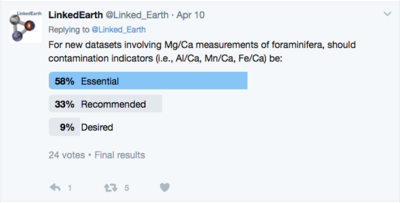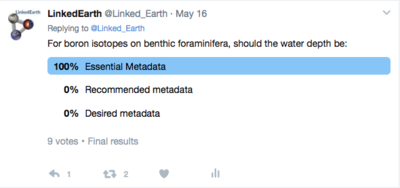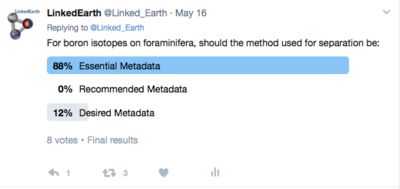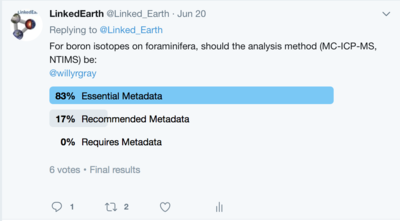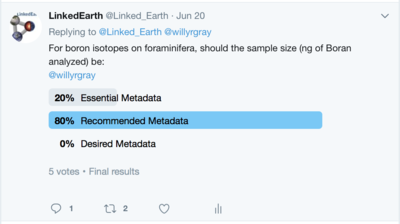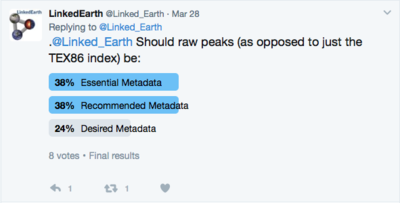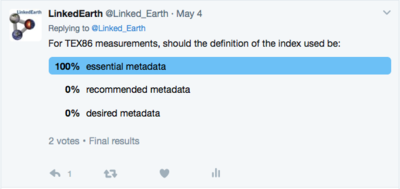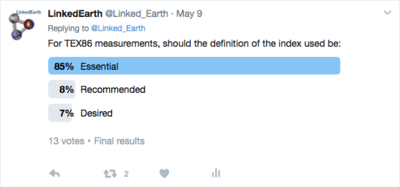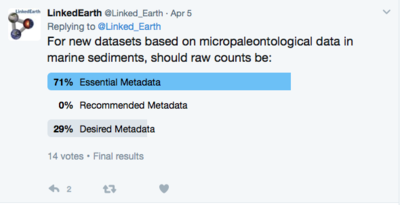Difference between revisions of "Category:Marine Sediment Working Group"
(poll warning) |
(→Magnetic data: Add polls) |
||
| (32 intermediate revisions by 3 users not shown) | |||
| Line 133: | Line 133: | ||
For versioning of datasets, see the proposed LinkedEarth standard [[: Property:DatasetVersion (L)| here]] and use the Discussion page to comment. | For versioning of datasets, see the proposed LinkedEarth standard [[: Property:DatasetVersion (L)| here]] and use the Discussion page to comment. | ||
| + | |||
| + | |||
| + | 'Additional' proxy data is widely measured along with the primary proxy data of interest (here, the primary data being the data discussed and interpreted in the manuscript). Often, this 'additional' data is not made publicly available, despite its potential utility for the community. For example, d13C is almost always measured along d18O in carbonates, many other trace element ratios are often measured alongside Mg/Ca in foraminifera, and multiple elements are measured by XRF core scanners. If it can be demonstrated that this 'additional' data has been measured accurately and precisely (i.e. by the reporting of standards), archiving this 'additional' data, along with the primary data, would allow its potential utility to be exploited. | ||
| + | |||
| + | [[File:TwitterPoll MarineSediment AdditionalProxys.png|thumb|right|400px|Results of the poll placed on Twitter between June 22nd and 27th 2017]] | ||
| + | |||
| + | <poll> | ||
| + | Should any 'additional' proxy data measured along the primary data of interest be archived with the dataset? | ||
| + | Yes | ||
| + | If identified as not part of peer-reviewed study | ||
| + | No | ||
| + | </poll> | ||
== Marine Sediment Standards == | == Marine Sediment Standards == | ||
| Line 206: | Line 218: | ||
|- | |- | ||
| Method Reference || R || Literature Reference for analytical method || [[User:Richey|Julie]] ([[User talk:Richey|talk]]), 28 March 2017 following suggestion of Jason Addison | | Method Reference || R || Literature Reference for analytical method || [[User:Richey|Julie]] ([[User talk:Richey|talk]]), 28 March 2017 following suggestion of Jason Addison | ||
| + | |- | ||
| + | | Raw spectral counts || D || Raw data derived from the XRF analyzer to enable reprocessing || [[User:nick mckay]], 15 September 2017 | ||
|- | |- | ||
| Environmental Parameter || D || For instance, is the geochemical proxy sensitive to upwelling intensity, salinity, temperature, terrestrial input, etc. This is the [[:Category:Interpretation_(L)]] field in the current LinkedEarth ontology.|| [[User:Richey|Julie]] ([[User talk:Richey|talk]]), 28 March 2017 | | Environmental Parameter || D || For instance, is the geochemical proxy sensitive to upwelling intensity, salinity, temperature, terrestrial input, etc. This is the [[:Category:Interpretation_(L)]] field in the current LinkedEarth ontology.|| [[User:Richey|Julie]] ([[User talk:Richey|talk]]), 28 March 2017 | ||
| Line 221: | Line 235: | ||
Desired Metadata | Desired Metadata | ||
</poll> | </poll> | ||
| + | |||
| + | [[File:TwitterPoll BulkMarineSed AnalyticalMethod.png | 400px | thumb | right | Results of the poll placed on Twitter from May 16th to 23rd 2017]] | ||
<poll> | <poll> | ||
| Line 242: | Line 258: | ||
Desired Metadata | Desired Metadata | ||
</poll> | </poll> | ||
| + | |||
| + | [[File:TwitterPoll BulkMarineSediment MethodReference.png | 400px | right |thumb | Results of the poll placed on Twitter between July 13th and 20th 2017]] | ||
<poll> | <poll> | ||
| Line 262: | Line 280: | ||
'''Note''': Do not edit the polls (even for typos) once voting has started as it will reset the vote counts to zero. If a change needs to be made, make an annotation above the old poll (i.e., above the poll tags) and place the new poll below the first one. | '''Note''': Do not edit the polls (even for typos) once voting has started as it will reset the vote counts to zero. If a change needs to be made, make an annotation above the old poll (i.e., above the poll tags) and place the new poll below the first one. | ||
| + | |||
| + | [[File:TwitterPoll Foraminifera Taxonomy.png | thumb | 400px | right | Results of the poll placed on Twitter from May 16th to 23rd 2017]] | ||
<poll> | <poll> | ||
| Line 354: | Line 374: | ||
Desired Metadata | Desired Metadata | ||
</poll> | </poll> | ||
| + | |||
| + | [[File:TwitterPoll StableIsotopeForaminifera Standard.png | thumb | 400px | right | Results of the poll placed on Twitter from May 9th to 16th 2017]] | ||
<poll> | <poll> | ||
| Line 361: | Line 383: | ||
Desired Metadata | Desired Metadata | ||
</poll> | </poll> | ||
| + | |||
| + | [[File:TwitterPoll Foraminifera AnalyticalPrecision.png | 400px | thumb | right | Results of the poll placed on Twitter from May 9th to 16th 2017]] | ||
<poll> | <poll> | ||
| Line 384: | Line 408: | ||
Desired Metadata | Desired Metadata | ||
</poll> | </poll> | ||
| + | |||
| + | [[File:TwitterPoll StableIsotopeForaminifera EquilibirumOffset 1.png | thumb | right | 400px | Results of the poll placed on Twitter between May 4th and 5th 2017]] | ||
| + | [[File:TwitterPoll StableIsotopeForaminifera EquilibirumCorrection.png | thumb | right | 400px | Results of the poll placed on Twitter between May 9th and 16th 2017]] | ||
<poll> | <poll> | ||
| Line 392: | Line 419: | ||
</poll> | </poll> | ||
| − | [[File:TwitterPoll MarineSediments SensorSeasonality.png|thumb|400px|right|Results of the poll | + | [[File:TwitterPoll MarineSediments SensorSeasonality.png|thumb|400px|right|Results of the poll run on Twitter from April 3rd to 10th 2017]] |
<poll> | <poll> | ||
| Line 400: | Line 427: | ||
Desired Metadata | Desired Metadata | ||
</poll> | </poll> | ||
| + | |||
| + | [[File:TwitterPoll StableIsotopesForams HabitatDepth.png | 400px | right | thumb | Results of the poll run on Twitter between July 7th and 14th 2017]] | ||
<poll> | <poll> | ||
| Line 408: | Line 437: | ||
</poll> | </poll> | ||
| − | ==== Trace | + | ==== Trace Elements ==== |
From [[User:Jfehrenbacher|Jfehrenbacher]]: | From [[User:Jfehrenbacher|Jfehrenbacher]]: | ||
"The properties described under Mg/Ca can be used for the other trace elements." | "The properties described under Mg/Ca can be used for the other trace elements." | ||
| + | |||
| + | 'Additional' trace element data is widely measured along with the primary trace element data of interest (here, the primary data being the data discussed and interpreted in the manuscript). Often, this additional trace element data is not made publicly available, despite its potential utility for the community. For example, Sr/Ca is almost always measured along with Mg/Ca, but rarely interpreted or published. If it can be demonstrated that this 'additional' data has been measured accurately and precisely (i.e. by the reporting of standards), archiving this 'additional' data, along with the primary data, would allow its potential utility to be exploited. | ||
Additional information may be required for other trace elements (for example, for B/Ca were the samples cleaned in a hood with a B-free HEPA filter). | Additional information may be required for other trace elements (for example, for B/Ca were the samples cleaned in a hood with a B-free HEPA filter). | ||
| Line 456: | Line 487: | ||
| Contamination indicators || R || Ancillary trace element data to asses contamination (e.g. Al/Ca, Mn/Ca, Fe/Ca) || [[User:Williamrgray|William Gray]] ([[User talk:Williamrgray|talk]]) 17:12, 17 March 2017 (GMT) | | Contamination indicators || R || Ancillary trace element data to asses contamination (e.g. Al/Ca, Mn/Ca, Fe/Ca) || [[User:Williamrgray|William Gray]] ([[User talk:Williamrgray|talk]]) 17:12, 17 March 2017 (GMT) | ||
|- | |- | ||
| − | | [[:Property:Standard (L)]]|| D || The value of any certified reference material analysed by the lab (e.g. ECRM 752-1) | + | | [[:Property:Standard (L)]]|| D || The value of any certified reference material analysed by the lab (e.g. ECRM 752-1). NIST are currently developing a 'syntetic foram' standard (RM8301) which should be available soon, and should be adopted by the community as the go-to foram trace element standard and make it much easier to compared data analysed in different labs. || [[User:Williamrgray|William Gray]] ([[User talk:Williamrgray|talk]]) 17:24, 17 March 2017 (GMT) |
|- | |- | ||
| "Raw" Mg/Ca data || E || It is essential the Mg/Ca data are available - not just derived temperature values || [[User:Williamrgray|William Gray]] ([[User talk:Williamrgray|talk]]) 18:12, 20 March 2017 (GMT) | | "Raw" Mg/Ca data || E || It is essential the Mg/Ca data are available - not just derived temperature values || [[User:Williamrgray|William Gray]] ([[User talk:Williamrgray|talk]]) 18:12, 20 March 2017 (GMT) | ||
| Line 502: | Line 533: | ||
Desired Metadata | Desired Metadata | ||
</poll> | </poll> | ||
| + | |||
| + | [[File:TwitterPoll MarineSediment ForamMgCa CleaninMethodologyRef.png|400px|thumb|right|Results of the poll placed on Twittter between July 13th and 20th 2017]] | ||
<poll> | <poll> | ||
| Line 523: | Line 556: | ||
Desired Metadata | Desired Metadata | ||
</poll> | </poll> | ||
| + | |||
| + | [[File:TwitterPoll TraceElementsFormas NumberofSpecimens.png | thumb | 400px | right | Results of the poll placed on Twitter between June 7th and 14th 2017]] | ||
<poll> | <poll> | ||
| Line 616: | Line 651: | ||
|- | |- | ||
|} | |} | ||
| + | |||
| + | To gather rapid feedback on whether the proposed metadata should be essential, recommended or optional, answer the polls below: | ||
| + | |||
| + | '''Note''': Do not edit the polls (even for typos) once voting has started as it will reset the vote counts to zero. If a change needs to be made, make an annotation above the old poll (i.e., above the poll tags) and place the new poll below the first one. | ||
| + | |||
| + | <poll> | ||
| + | For boron isotopes on foraminifera, should the location of the archive be: | ||
| + | Essential Metadata | ||
| + | Recommended Metadata | ||
| + | Desired Metadata | ||
| + | </poll> | ||
| + | |||
| + | <poll> | ||
| + | For boron isotopes on planktonic foraminifera, should the water depth be: | ||
| + | Essential Metadata | ||
| + | Recommended Metadata | ||
| + | Desired Metadata | ||
| + | </poll> | ||
| + | |||
| + | [[File:TwitterPoll BoronIsotopes BenthicForams WaterDepth.png |thumb | right | 400px | Results of the poll placed on Twitter between May 16th and 23rd 2017]] | ||
| + | |||
| + | <poll> | ||
| + | For boron isotopes on benthic foraminifera, should the water depth be: | ||
| + | Essential Metadata | ||
| + | Recommended Metadata | ||
| + | Desired Metadata | ||
| + | </poll> | ||
| + | |||
| + | <poll> | ||
| + | For boron isotopes on foraminifera, should the Genus/Species information be: | ||
| + | Essential Metadata | ||
| + | Recommended Metadata | ||
| + | Desired Metadata | ||
| + | </poll> | ||
| + | |||
| + | <poll> | ||
| + | For boron isotopes on foraminifera, should the sample depth on the archive be: | ||
| + | Essential Metadata | ||
| + | Recommended Metadata | ||
| + | Desired Metadata | ||
| + | </poll> | ||
| + | |||
| + | <poll> | ||
| + | For boron isotopes on foraminifera in new datasets, should the chronology information be: | ||
| + | Essential Metadata | ||
| + | Recommended Metadata | ||
| + | Desired Metadata | ||
| + | </poll> | ||
| + | |||
| + | <poll> | ||
| + | For boron isotopes on foraminifera in legacy datasets, should the chronology information be: | ||
| + | Essential Metadata | ||
| + | Recommended Metadata | ||
| + | Desired Metadata | ||
| + | </poll> | ||
| + | |||
| + | [[File:TwitterPoll BoronIsotopes separationmethod.png | thumb | right | 400px | Results of the poll placed on Twitter between May 16th to 23rd 2017]] | ||
| + | |||
| + | <poll> | ||
| + | For boron isotopes on foraminifera, should the method used for separation be: | ||
| + | Essential Metadata | ||
| + | Recommended Metadata | ||
| + | Desired Metadata | ||
| + | </poll> | ||
| + | |||
| + | [[File:TwitterPoll MarineSediment BoronAnalysisMethod.png | thumb | right |400px | Results of the poll placed on Twitter between June 20th to 27th 2017]] | ||
| + | |||
| + | <poll> | ||
| + | For boron isotopes on foraminifera, should the analysis method (MC-ICP-MS, NTIMS) be: | ||
| + | Essential Metadata | ||
| + | Recommended Metadata | ||
| + | Desired Metadata | ||
| + | </poll> | ||
| + | |||
| + | [[File:TwitterPoll MarineSediments MassofBoron.png | thumb | right |400px | Results of the poll placed on Twitter between June 20th to 27th 2017]] | ||
| + | |||
| + | <poll> | ||
| + | For boron isotopes on foraminifera, should the sample size (ng of Boron analyzed) be: | ||
| + | Essential Metadata | ||
| + | Recommended Metadata | ||
| + | Desired Metadata | ||
| + | </poll> | ||
| + | |||
| + | <poll> | ||
| + | For boron isotopes on foraminifera, should the standard value for certified reference materials be: | ||
| + | Essential Metadata | ||
| + | Recommended Metadata | ||
| + | Desired Metadata | ||
| + | </poll> | ||
| + | |||
| + | <poll> | ||
| + | For boron isotopes on foraminifera, should the analytical precision be: | ||
| + | Essential Metadata | ||
| + | Recommended Metadata | ||
| + | Desired Metadata | ||
| + | </poll> | ||
===Organic Geochemistry=== | ===Organic Geochemistry=== | ||
| Line 627: | Line 758: | ||
! Metadata || Essential (E)/ Recommended (R) / Desired (D) || Reason || Added by (optional) | ! Metadata || Essential (E)/ Recommended (R) / Desired (D) || Reason || Added by (optional) | ||
|- | |- | ||
| − | | [[:Category: | + | | [[:Category: Location_(L)]] (Lat, Lon) || E || Location is a must || [[User:Richey|Julie]] ([[User talk:Richey|talk]]), 22 March 2017 |
|- | |- | ||
| − | | | [[:Property:Wgs84:Alt | + | | | [[:Property:Wgs84:Alt (L)]] (Depth) || E || Water depth can be useful to get an idea of diagenesis in the core. Especially for deep-sea drilling sediments, water depths can be important to assess various biogeochemical properties || [[User:Richey|Julie]] ([[User talk:Richey|talk]]), 22 March 2017 |
|- | |- | ||
| Line 654: | Line 785: | ||
|- | |- | ||
| Alkenone Concentration|| D|| Calculated concentration of alkenone||[[User:Richey|Julie]] ([[User talk:Richey|talk]]), 22 March 2017 | | Alkenone Concentration|| D|| Calculated concentration of alkenone||[[User:Richey|Julie]] ([[User talk:Richey|talk]]), 22 March 2017 | ||
| − | + | |- | |
| + | | C37-C39 compound concentration || D || || [[User:Khider|Deborah Khider]] ([[User talk:Khider|talk]]) 13:43, 25 July 2017 (PDT) from Markus Kienast | ||
| + | |- | ||
| + | | Analytical method ||D|| Retention time vs mass spec, LOD, and LOQ || [[User:Khider|Deborah Khider]] ([[User talk:Khider|talk]]) 13:43, 25 July 2017 (PDT) from Markus Kienast | ||
|} | |} | ||
| + | |||
| + | To gather rapid feedback on whether the proposed metadata should be essential, recommended or optional, answer the polls below: | ||
| + | |||
| + | Note: Do not edit the polls (even for typos) once voting has started as it will reset the vote counts to zero. If a change needs to be made, make an annotation above the old poll (i.e., above the poll tags) and place the new poll below the first one. | ||
| + | |||
| + | <poll> | ||
| + | For alkenones measurements in marine sediments, should the location information of the archive be: | ||
| + | Essential metadata | ||
| + | Recommended metadata | ||
| + | Desired metadata | ||
| + | </poll> | ||
| + | |||
| + | <poll> | ||
| + | For alkenones measurements in marine sediments, should the water depth be: | ||
| + | Essential metadata | ||
| + | Recommended metadata | ||
| + | Desired metadata | ||
| + | </poll> | ||
| + | |||
| + | <poll> | ||
| + | For alkenones measurements in marine sediments, should the sample depth in the archive be: | ||
| + | Essential metadata | ||
| + | Recommended metadata | ||
| + | Desired metadata | ||
| + | </poll> | ||
| + | |||
| + | <poll> | ||
| + | For alkenones measurements in marine sediments for new datasets, should chronology information be: | ||
| + | Essential metadata | ||
| + | Recommended metadata | ||
| + | Desired metadata | ||
| + | </poll> | ||
| + | |||
| + | <poll> | ||
| + | For alkenones measurements in marine sediments for legacy datasets, should chronology information be: | ||
| + | Essential metadata | ||
| + | Recommended metadata | ||
| + | Desired metadata | ||
| + | </poll> | ||
| + | |||
| + | <poll> | ||
| + | For alkenones measurements in marine sediments, should the uk'37/uk37 index be: | ||
| + | Essential metadata | ||
| + | Recommended metadata | ||
| + | Desired metadata | ||
| + | </poll> | ||
| + | |||
| + | <poll> | ||
| + | For alkenones measurements in marine sediments, should the analytical precision be: | ||
| + | Essential metadata | ||
| + | Recommended metadata | ||
| + | Desired metadata | ||
| + | </poll> | ||
| + | |||
| + | <poll> | ||
| + | For alkenones measurements in marine sediments, should the method of sediment extraction be: | ||
| + | Essential metadata | ||
| + | Recommended metadata | ||
| + | Desired metadata | ||
| + | </poll> | ||
| + | |||
| + | <poll> | ||
| + | For alkenones measurements in marine sediments, should the "raw" peak areas be: | ||
| + | Essential metadata | ||
| + | Recommended metadata | ||
| + | Desired metadata | ||
| + | </poll> | ||
| + | |||
| + | <poll> | ||
| + | For alkenones measurements in marine sediments, should the inferred SST be: | ||
| + | Essential metadata | ||
| + | Recommended metadata | ||
| + | Desired metadata | ||
| + | </poll> | ||
| + | |||
| + | <poll> | ||
| + | For alkenones measurements in marine sediments, should the calibration info used to transform the index into SST be: | ||
| + | Essential metadata | ||
| + | Recommended metadata | ||
| + | Desired metadata | ||
| + | </poll> | ||
| + | |||
| + | <poll> | ||
| + | For alkenones measurements in marine sediments, should the alkenone concentration be: | ||
| + | Essential metadata | ||
| + | Recommended metadata | ||
| + | Desired metadata | ||
| + | </poll> | ||
====GDGTs==== | ====GDGTs==== | ||
| Line 746: | Line 968: | ||
<poll> | <poll> | ||
For marine sediments and legacy datasets based on TEX86, should the method of sediment extraction be: | For marine sediments and legacy datasets based on TEX86, should the method of sediment extraction be: | ||
| + | Essential Metadata | ||
| + | Recommended Metadata | ||
| + | Desired Metadata | ||
| + | </poll> | ||
| + | |||
| + | <poll> | ||
| + | For marine sediments and new datasets based on TEX86, should the use of core lipids or IPLS be reported as: | ||
| + | Essential Metadata | ||
| + | Recommended Metadata | ||
| + | Desired Metadata | ||
| + | </poll> | ||
| + | |||
| + | <poll> | ||
| + | For marine sediments and legacy datasets based on TEX86, should the use of core lipids or IPLS be reported as: | ||
Essential Metadata | Essential Metadata | ||
Recommended Metadata | Recommended Metadata | ||
| Line 752: | Line 988: | ||
For polls regarding the analytical precision, see the [[:Category:Uncertainty Working Group | Uncertainty Working Group]] page. | For polls regarding the analytical precision, see the [[:Category:Uncertainty Working Group | Uncertainty Working Group]] page. | ||
| + | |||
| + | [[File:TwitterPoll TEX86 DefinitionofIndex 1.png | thumb | right | 400px | Results of the poll placed on Twitter between May 4th and 5th 2017]] | ||
| + | [[File:TwitterPoll TEX8 IndexDefinition.png | thumb | right | 400px | Results of the poll placed on Twitter between May 9th and 16th 2017]] | ||
| + | |||
| + | <poll> | ||
| + | For TEX86 measurements on marine sediments, should the definition of the index used be: | ||
| + | Essential Metadata | ||
| + | Recommended Metadata | ||
| + | Desired Metadata | ||
| + | </poll> | ||
| + | |||
| + | <poll> | ||
| + | For TEX86 measurements on marine sediments, should the inferred variable name be: | ||
| + | Essential Metadata | ||
| + | Recommended Metadata | ||
| + | Desired Metadata | ||
| + | </poll> | ||
| + | |||
| + | <poll> | ||
| + | For TEX86 measurements on marine sediments, should the calibration used be: | ||
| + | Essential Metadata | ||
| + | Recommended Metadata | ||
| + | Desired Metadata | ||
| + | </poll> | ||
====Compound specific isotopes==== | ====Compound specific isotopes==== | ||
| Line 758: | Line 1,018: | ||
===Grain Size=== | ===Grain Size=== | ||
| + | |||
| + | See polls on the [[:Category:Lake Sediments Working Group | lake sediment working group]]. | ||
==Micropaleontological Data == | ==Micropaleontological Data == | ||
| Line 820: | Line 1,082: | ||
Recommended Metadata | Recommended Metadata | ||
Desired Metadata | Desired Metadata | ||
| + | </poll> | ||
| + | |||
| + | == Magnetic data == | ||
| + | |||
| + | From Steve Lund | ||
| + | |||
| + | {| class="wikitable" | ||
| + | |- | ||
| + | |+Essential/Recommended/Desired Metadata for Magnetic Data | ||
| + | |- | ||
| + | ! Metadata || Essential (E)/ Recommended (R) / Desired (D) || Reason || Added by (optional) | ||
| + | |- | ||
| + | | [[:Category: Location_(L)]] (Lat, Lon) || E || Location is a must || [[User:Khider|Deborah Khider]] ([[User talk:Khider|talk]]) 12:02, 14 September 2017 (PDT) | ||
| + | |- | ||
| + | | [[:Property:Wgs84:Alt (L)]] (Depth) || E || || [[User:Khider|Deborah Khider]] ([[User talk:Khider|talk]]) 12:02, 14 September 2017 (PDT) | ||
| + | |- | ||
| + | | Ancillary data about the archive (carbonate and organic content) || R || || [[User:Khider|Deborah Khider]] ([[User talk:Khider|talk]]) 12:02, 14 September 2017 (PDT) | ||
| + | |- | ||
| + | | Flag that the signal recorded hasn't been altered by geochemistry || D || || [[User:Khider|Deborah Khider]] ([[User talk:Khider|talk]]) 12:02, 14 September 2017 (PDT) | ||
| + | |} | ||
| + | |||
| + | <poll> | ||
| + | For magnetic measurements made on marine sediment core, should ancillary data about the archive (carbonate and organic content) be: | ||
| + | Essential | ||
| + | Recommended | ||
| + | Desired | ||
| + | </poll> | ||
| + | |||
| + | <poll> | ||
| + | For magnetic measurements made on marine sediment core, should a flag that the signal recorded hasn't been altered by geochemistry be: | ||
| + | Essential | ||
| + | Recommended | ||
| + | Desired | ||
</poll> | </poll> | ||
Latest revision as of 18:36, 18 September 2017
Contents
Overview
In the Linked Earth context, a working group (WG) is a self-organized coalition of knowledgeable experts, whose activities are governed herewith. This page is dedicated to the discussion of data and metadata standards for marine sedimentary archives (see this page for a definition of Marine Sediment Archive), and aims to formulate a set of recommendations for such a standard.
Members
The group currently has one coordinator, Julie Richey (USGS)
Members of 'Marine Sediment Working Group'
This working group has 16 members.
Specific tasks
We recommend that discussions focus on the following considerations, and explore potential commonalities.
For each observation type, we recommend:
- structuring discussions around what scientific questions one would want to ask of the data
- listing essential, recommended, and desired information for:
- the measurements themselves
- any inference made from the measurements (e.g. calibration to temperature)
- the underlying uncertainties, and what those numbers correspond to (e.g. 1-sigma or 2-sigma?)
- providing an ideal data table, so the community knows what to report and how to report it.
- providing separate recommendations for new and legacy datasets, and for how to label measured and inferred variable (e.g. Mg/Ca is measured, temperature is inferred)
- thinking about how the rest of the paleoscience community, or other (non)scientists may make use of the data you describe.
Marine sediments are a very ubiquitous archive on which many types of observations are made, and involving thousands of people around the world. It seems wise for this WG to rally around sub-groups start dedicated to data standards about the following sensors/observation types.
Previous standardization efforts
A discussion regarding paleoclimate data standards was started during the PMIP Ocean Workshop: Understanding changes since the Last Glacial Maximum (hereafter, PMIP_LGM) in Corvallis, OR in December 2013. Given the expertise of the working group members, the discussion focus on sedimentary archives. Meeting notes can be found here and summarized in the sections below.
The recommendations made at the workshop concerned new datasets only. It was recognized that different sets of standards would be necessary for legacy datasets.
Types of Data
There are three principle types of data that are relevant for the paleoceanography/paleoclimatology community:
Original data values
this would include raw values of all variables measured or otherwise determined on the substrate of interest, recorded against an unambiguous sample identifier (for instance, depth in the archive). This includes age control points (ACP) used to derive the age model of the paleo-time series, including radioisotopes (14C, excess 210Pb), and benthic stack comparison. All data that are reported for the first time in a scientific publication should be treated as original. The procedure of obtaining original data should be documented such as to allow full replication of the results. In the LinkedEarth Ontology, the original data values are referred as Category:MeasuredVariable_(L).
Note: Do not edit the polls (even for typos) once voting has started as it will reset the vote counts to zero. If a change needs to be made, make an annotation above the old poll (i.e., above the poll tags) and place the new poll below the first one.
You are not entitled to view results of this poll.
You are not entitled to view results of this poll.
Depth can be problematic as a unique identifier since there are several to calculate or report depth in a sample (i.e., top-depth, mid-depth, depth interval.) and IODP uses several depth scales.
You are not entitled to view results of this poll.
Deborah Khider (talk) 15:29, 7 March 2017 (PST): I probably forgot ways of expressing depth, please add comments below.
Derived data values
this category refers to values of variables derived from other variables, derived or raw, original or compiled, reported against an unambiguous sample identifier and accompanied with a documentation of the derivation procedure such as to allow full replication of the result. This category includes algorithms of any kind relating depth to age that have been used to assign ages to values of raw or derived variables. In the LinkedEarth Ontology, derived data values are referred to as Category:InferredVariable_(L).
The derivation procedure is contained in the Category: CalibrationModel_(L).
Note: Do not edit the polls (even for typos) once voting has started as it will reset the vote counts to zero. If a change needs to be made, make an annotation above the old poll (i.e., above the poll tags) and place the new poll below the first one.
You are not entitled to view results of this poll.
You are not entitled to view results of this poll.
You are not entitled to view results of this poll.
Compilation of data values
this refers to raw values of all variables from published sources, gathered for the purpose of quantitative treatment, recorded against an unambiguous sample identifier and labelled with an unambiguous reference to the publication where such data were originally presented. Reporting of data compilations is required wherever these are used to derive patterns or variables from the data other than those reported in the original publication.
Note: Do not edit the polls (even for typos) once voting has started as it will reset the vote counts to zero. If a change needs to be made, make an annotation above the old poll (i.e., above the poll tags) and place the new poll below the first one.
Archived poll
You are not entitled to view results of this poll.
New poll includes both option:
You are not entitled to view results of this poll.
LinkedEarth identifies each series using Property:HasVariableID_(L)
Archiving
The following recommendations were made at the PMIP_LGM workshop:
The data should be archived in easily accessible database administered by an editorial board. The database should included on on-line system for (1) the reporting of errors, (2) a community-driven quality flag system, and (3) the update of datasets as new data become available. Updates to a particular dataset should be assigned a version number with a link to the old and new references. The editorial board should also be tasked in identifying and archiving older datasets.
For versioning of datasets, see the proposed LinkedEarth standard here and use the Discussion page to comment.
'Additional' proxy data is widely measured along with the primary proxy data of interest (here, the primary data being the data discussed and interpreted in the manuscript). Often, this 'additional' data is not made publicly available, despite its potential utility for the community. For example, d13C is almost always measured along d18O in carbonates, many other trace element ratios are often measured alongside Mg/Ca in foraminifera, and multiple elements are measured by XRF core scanners. If it can be demonstrated that this 'additional' data has been measured accurately and precisely (i.e. by the reporting of standards), archiving this 'additional' data, along with the primary data, would allow its potential utility to be exploited.
You are not entitled to view results of this poll.
Marine Sediment Standards
| Metadata | Essential (E)/ Recommended (R) / Desired (D) | Reason | Added by (optional) |
|---|---|---|---|
| Collection Method: Gear Type | D | Some coring techniques are known to stretch/compress the cores (i.e. Marion Dufresne piston core) | Deborah Khider (talk) 16:17, 7 March 2017 (PST) |
| Collection method: Volume of sediment analyzed | D | May not be useful for all types of data measured on sediment cores. If deemed recommend or essential, insert comment/poll in appropriate section | Deborah Khider (talk) 16:17, 7 March 2017 (PST) |
| Collection method: Sampling methods | D | u-channel, syringe, slice | Deborah Khider (talk) 16:17, 7 March 2017 (PST) |
| Instrumentation | D | How were the MeasuredVariables measured? Desired for standard analytical techniques. Should be essential/recommended for new techniques | Deborah Khider (talk) 16:23, 7 March 2017 (PST) |
Note: Do not edit the polls (even for typos) once voting has started as it will reset the vote counts to zero. If a change needs to be made, make an annotation above the old poll (i.e., above the poll tags) and place the new poll below the first one.
You are not entitled to view results of this poll.
You are not entitled to view results of this poll.
You are not entitled to view results of this poll.
You are not entitled to view results of this poll.
Geochemical Data
Bulk Sediment Geochemistry
| Metadata | Essential (E)/ Recommended (R) / Desired (D) | Reason | Added by (optional) |
|---|---|---|---|
| Category: Location_(L) (Lat, Lon) | E | Location is a must | Kau (talk) 13:34, 7 March 2017 (PST) |
| Property:Wgs84:Alt (L) (Depth) | R | Especially for deep-sea drilling sediments, water depths can be important to assess various biogeochemical properties and parameters of stable isotopic parameters | Kau (talk) 13:34, 7 March 2017 (PST) |
| Sample Pretreatment | R | Freeze-dried, ground in mortar and pestle, acid-washed, microwave digestion, pressed pellet, glass bead, sieved, scraped core surface and x-ray transparent film, thin sections [single or double-polished, thickness, epoxy type, mounting medium] | Julie (talk), 28 March 2017 following suggestion of Jason Addison |
| Analytical Method | E | ICP-MS, XRF, scanning XRF, wet chemistry spectrophotometry, INAA, micro-XRF, electron microprobe, HCNS elemental analyzer, carbonate coulometry | Julie (talk), 28 March 2017 following suggestion of Jason Addison |
| Measurement Parameter | E | i.e., Mg to U, Mo, opal, TOC, CaCO3, C/N, etc. | Julie (talk), 28 March 2017 following suggestion of Jason Addison |
| Units of measurement | E | wt%, ppm, x-ray intensities (counts per second) | Julie (talk), 28 March 2017 following suggestion of Jason Addison |
| Method Reference | R | Literature Reference for analytical method | Julie (talk), 28 March 2017 following suggestion of Jason Addison |
| Raw spectral counts | D | Raw data derived from the XRF analyzer to enable reprocessing | User:nick mckay, 15 September 2017 |
| Environmental Parameter | D | For instance, is the geochemical proxy sensitive to upwelling intensity, salinity, temperature, terrestrial input, etc. This is the Category:Interpretation_(L) field in the current LinkedEarth ontology. | Julie (talk), 28 March 2017 |
Note: Do not edit the polls (even for typos) once voting has started as it will reset the vote counts to zero. If a change needs to be made, make an annotation above the old poll (i.e., above the poll tags) and place the new poll below the first one.
You are not entitled to view results of this poll.
You are not entitled to view results of this poll.
You are not entitled to view results of this poll.
You are not entitled to view results of this poll.
You are not entitled to view results of this poll.
You are not entitled to view results of this poll.
Foraminiferal Geochemistry
Note: Do not edit the polls (even for typos) once voting has started as it will reset the vote counts to zero. If a change needs to be made, make an annotation above the old poll (i.e., above the poll tags) and place the new poll below the first one.
You are not entitled to view results of this poll.
Stable isotopes
In the following table, enter the metadata that you'd wish every member of the stable isotope community would enter to make their data reproducible. To add more lines, follow this guide. For a definition of Essential (E)/ Recommended (R)/ Desired (D), see this page.
| Metadata | Essential (E)/ Recommended (R) / Desired (D) | Reason | Added by (optional) |
|---|---|---|---|
| Category: Location_(L) (Lat, Lon) | E | Location is a must | Kau (talk) 13:34, 7 March 2017 (PST) |
| Property:Wgs84:Alt (L) (Depth) | R | Especially for deep-sea drilling sediments, water depths can be important to assess various biogeochemical properties and parameters of stable isotopic parameters | Kau (talk) 13:34, 7 March 2017 (PST) |
| Property:SensorGenus_(L) Property:SensorSpecies_(L) | E | Species information needed to infer which section of the water column is being recorded | Kau (talk) 13:34, 7 March 2017 (PST) |
| Cleaning Methodology(oxidative vs reductive) | R | Useful to correct for offsets, especially for compilation work although a quick plot can often help figure out the cleaning methodology | Kau (talk) 13:34, 7 March 2017 (PST) |
| Cleaning Methodology reference | D | The exact reference to the protocol used for cleaning. Added to differentiate between the actual methodology and the specific protocol. | Deborah Khider (talk) 11:05, 17 March 2017 (PDT) following a conversation with Jfehrenbacher |
| Sample Depth | E | Positional information needed to relate the samples back to the archive | Kau (talk) 13:34, 7 March 2017 (PST) |
| ChonDataTable | E for new datasets/ R for legacy datasets | The raw radiocarbon, tie points, 210Pb measurements should be made available so that age models can be updated in light of new calibration curves or new age modeling techniques | Kau (talk) 13:34, 7 March 2017 (PST) |
| Number of specimens utilized per sample | R | The number of foraminiferal tests used per sample can be used to understand the sampling uncertainity associated with the measurements based on the signal-to-noise ratio of the climate signal at the location (planktic foraminifera live for 2-4 weeks) | Kau (talk) 13:34, 7 March 2017 (PST) |
| Property:Standard (L) | E | The standard against which the measurements are reported (especially for d18O). VBDP vs VSMOW | Deborah Khider (talk) 13:41, 7 March 2017 (PST) |
| Analytical Precision | R | The machine precision based on reproducability of standards | Kau (talk) 13:49, 7 March 2017 (PST) |
| Size Fraction | R | Stable isotopes ratios have been shown to vary by size fraction in several studies | Deborah Khider (talk) 15:48, 7 March 2017 (PST) |
| Method of sediment disintegration and washing | D | Brought up at the PMIP_LGM meeting | Deborah Khider (talk) 16:19, 7 March 2017 (PST) |
| Correction applied/Equilibration offset | R | For instance, correction for offsets in benthic species (critical for compilation work) | Deborah Khider (talk) 16:27, 7 March 2017 (PST) |
| Seasonality | R | Necessary for compilation work especially as to not combine summer and winter ProxySensors | Deborah Khider (talk) 11:39, 8 March 2017 (PST) |
| Habitat Depth | R | Which part of the water column is being represented | Deborah Khider (talk) 11:39, 8 March 2017 (PST) |
To gather rapid feedback on whether the proposed metadata should be essential, recommended or optional, answer the polls below:
Note: Do not edit the polls (even for typos) once voting has started as it will reset the vote counts to zero. If a change needs to be made, make an annotation above the old poll (i.e., above the poll tags) and place the new poll below the first one.
You are not entitled to view results of this poll.
You are not entitled to view results of this poll.
You are not entitled to view results of this poll.
You are not entitled to view results of this poll.
You are not entitled to view results of this poll.
You are not entitled to view results of this poll.
You are not entitled to view results of this poll.
You are not entitled to view results of this poll.
You are not entitled to view results of this poll.
You are not entitled to view results of this poll.
You are not entitled to view results of this poll.
You are not entitled to view results of this poll.
Trace Elements
From Jfehrenbacher:
"The properties described under Mg/Ca can be used for the other trace elements."
'Additional' trace element data is widely measured along with the primary trace element data of interest (here, the primary data being the data discussed and interpreted in the manuscript). Often, this additional trace element data is not made publicly available, despite its potential utility for the community. For example, Sr/Ca is almost always measured along with Mg/Ca, but rarely interpreted or published. If it can be demonstrated that this 'additional' data has been measured accurately and precisely (i.e. by the reporting of standards), archiving this 'additional' data, along with the primary data, would allow its potential utility to be exploited.
Additional information may be required for other trace elements (for example, for B/Ca were the samples cleaned in a hood with a B-free HEPA filter).
Mg/Ca
In the following table, enter the metadata that you'd wish every member of the Mg/Ca community would enter to make their data reproducible. To add more lines, follow this guide. For a definition of Essential (E)/ Recommended (R)/ Desired (D), see this page.
| Metadata | Essential (E)/ Recommended (R) / Desired (D) | Reason | Added by (optional) |
|---|---|---|---|
| Category: Location_(L) (Lat, Lon) | E | Location is a must | Deborah Khider (talk) 12:37, 17 February 2017 (PST) |
| Property:Wgs84:Alt (L) (Depth) | E | Water depth can be useful to get an idea of dissolution in the core. Especially for deep-sea drilling sediments, water depths can be important to assess various biogeochemical properties and parameters of stable isotopic parameters | Kau (talk) 13:39, 7 March 2017 (PST) |
| Property:SensorGenus_(L) Property:SensorSpecies_(L) | E | Species information needed to infer which section of the water column is being recorded | Deborah Khider (talk) 12:37, 17 February 2017 (PST) |
| Cleaning Methodology (oxidative vs reductive) | E for new datasets/ R or D for legacy datasets. | Useful to correct for offsets, especially for compilation work although a quick plot can often help figure out the cleaning methodology | Deborah Khider (talk) 12:37, 17 February 2017 (PST) Changed by Deborah Khider (talk) 11:22, 17 March 2017 (PDT) after a discussion with Jfehrenbacher |
| Cleaning methodology reference | D or R for both legacy and new datasets | The reference describing the specific protocol being followed (i.e., Barker et al., Martin and Lea...). Allows to differentiate between the general method being followed and the actual protocol | Deborah Khider (talk) 11:22, 17 March 2017 (PDT) after a discussion with Jfehrenbacher |
| Sample Depth | E | Positional information needed to relate the samples back to the archive | Deborah Khider (talk) 12:37, 17 February 2017 (PST) |
| ChonDataTable | E for new datasets/ R for legacy datasets | The raw radiocarbon, tie points, 210Pb measurements should be made available so that age models can be updated in light of new calibration curves or new age modeling techniques | Deborah Khider (talk) 12:37, 17 February 2017 (PST) |
| Number of specimens utilized per sample | R | The number of foraminiferal tests used per sample can be used to understand the sampling uncertainity associated with the measurements based on the signal-to-noise ratio of the climate signal at the location (planktic foraminifera live for 2-4 weeks) | Kau (talk) 13:17, 7 March 2017 (PST) |
| Analytical Precision | D | Uncertainty in the measurements | Deborah Khider (talk) 13:51, 7 March 2017 (PST) |
| Size fraction | R | Mg/Ca and other trace element ratios have been shown to vary with specimens size | Deborah Khider (talk) 15:49, 7 March 2017 (PST) |
| Method of sediment disintegration and washing | D | Brought up at the PMIP_LGM workshop | Deborah Khider (talk) 16:20, 7 March 2017 (PST) |
| Correction applied/Equilibrium offset | R | For instance, correction for offsets for cleaning methodologies (critical for compilation work) | Deborah Khider (talk) 16:27, 7 March 2017 (PST) |
| Seasonality | R | Necessary for compilation work especially as to not combine summer and winter ProxySensors | Deborah Khider (talk) 11:39, 8 March 2017 (PST) |
| Habitat Depth | R | Which part of the water column is being represented | Deborah Khider (talk) 11:39, 8 March 2017 (PST) |
| Contamination indicators | R | Ancillary trace element data to asses contamination (e.g. Al/Ca, Mn/Ca, Fe/Ca) | William Gray (talk) 17:12, 17 March 2017 (GMT) |
| Property:Standard (L) | D | The value of any certified reference material analysed by the lab (e.g. ECRM 752-1). NIST are currently developing a 'syntetic foram' standard (RM8301) which should be available soon, and should be adopted by the community as the go-to foram trace element standard and make it much easier to compared data analysed in different labs. | William Gray (talk) 17:24, 17 March 2017 (GMT) |
| "Raw" Mg/Ca data | E | It is essential the Mg/Ca data are available - not just derived temperature values | William Gray (talk) 18:12, 20 March 2017 (GMT) |
To gather rapid feedback on whether the proposed metadata should be essential, recommended or optional, answer the polls below:
Note: Do not edit the polls (even for typos) once voting has started as it will reset the vote counts to zero. If a change needs to be made, make an annotation above the old poll (i.e., above the poll tags) and place the new poll below the first one.
You are not entitled to view results of this poll.
You are not entitled to view results of this poll.
You are not entitled to view results of this poll.
More specific polls on cleaning methodology (see table above):
You are not entitled to view results of this poll.
You are not entitled to view results of this poll.
You are not entitled to view results of this poll.
You are not entitled to view results of this poll.
You are not entitled to view results of this poll.
You are not entitled to view results of this poll.
You are not entitled to view results of this poll.
You are not entitled to view results of this poll.
You are not entitled to view results of this poll.
This question is unclear - what does equilibrium refer to for Mg/Ca?
Correction to changes in seawater Mg/Ca ratio over time Deborah Khider (talk) 17:04, 31 March 2017 (PDT)
You are not entitled to view results of this poll.
You are not entitled to view results of this poll.
You are not entitled to view results of this poll.
You are not entitled to view results of this poll.
Boron isotopes
In the following table, enter the metadata that you'd wish every member of the stable isotope community would enter to make their data reproducible. To add more lines, follow this guide. For a definition of Essential (E)/ Recommended (R)/ Desired (D), see this page.
| Metadata | Essential (E)/ Recommended (R) / Desired (D) | Reason | Added by (optional) |
|---|---|---|---|
| Category: Location_(L) (Lat, Lon) | E | Location is a must | William Gray (talk) 17:29, 17 March 2017 (GMT) |
| Property:Wgs84:Alt (L) (Depth) | R/E | Water depth is Recommended for planktonic foraminifera and Essential for benthic foraminferal data | William Gray (talk) 17:29, 17 March 2017 (GMT) |
| Property:SensorGenus_(L) Property:SensorSpecies_(L) | E | Planktonic species show different relationships to d11B of borate and infuanal benthic species show offsets from seawater values | William Gray (talk) 17:29, 17 March 2017 (GMT) |
| Sample Depth | E | Positional information needed to relate the samples back to the archive | William Gray (talk) 17:29, 17 March 2017 (GMT) |
| ChonDataTable | E for new datasets/ R for legacy datasets | The raw radiocarbon, tie points, 210Pb measurements should be made available so that age models can be updated in light of new calibration curves or new age modeling techniques | William Gray (talk) 17:29, 17 March 2017 (GMT) |
| Analytical Method | E | The analytical method used for seperation (e.g. Amberlite columns, micro sublimation ) and analysis (MC-ICP-MS, NTIMS) | William Gray (talk) 17:29, 17 March 2017 (GMT) |
| Sample size | R | ng of Boron analysed | William Gray (talk) 17:29, 17 March 2017 (GMT) |
| Property:Standard (L) | E | The values for certified reference materials, both boric acids and carbonates (e.g. JCP, JCT, AE121) | William Gray (talk) 17:29, 17 March 2017 (GMT) |
| Analytical precision | E | Precision based on reproducibility of standards, may be a function of sample size | William Gray (talk) 17:29, 17 March 2017 (GMT) |
To gather rapid feedback on whether the proposed metadata should be essential, recommended or optional, answer the polls below:
Note: Do not edit the polls (even for typos) once voting has started as it will reset the vote counts to zero. If a change needs to be made, make an annotation above the old poll (i.e., above the poll tags) and place the new poll below the first one.
You are not entitled to view results of this poll.
You are not entitled to view results of this poll.
You are not entitled to view results of this poll.
You are not entitled to view results of this poll.
You are not entitled to view results of this poll.
You are not entitled to view results of this poll.
You are not entitled to view results of this poll.
You are not entitled to view results of this poll.
You are not entitled to view results of this poll.
You are not entitled to view results of this poll.
You are not entitled to view results of this poll.
You are not entitled to view results of this poll.
Organic Geochemistry
Alkenones
| Metadata | Essential (E)/ Recommended (R) / Desired (D) | Reason | Added by (optional) |
|---|---|---|---|
| Category: Location_(L) (Lat, Lon) | E | Location is a must | Julie (talk), 22 March 2017 |
| Property:Wgs84:Alt (L) (Depth) | E | Water depth can be useful to get an idea of diagenesis in the core. Especially for deep-sea drilling sediments, water depths can be important to assess various biogeochemical properties | Julie (talk), 22 March 2017 |
| Sample Depth | E | Positional information needed to relate the samples back to the archive | Julie (talk), 22 March 2017 |
| ChonDataTable | E for new datasets/ R for legacy datasets | The raw radiocarbon, tie points, 210Pb measurements should be made available so that age models can be updated in light of new calibration curves or new age modeling techniques | Julie (talk), 22 March 2017 |
| Uk’37 index | E | Unsaturation index of C37 alkenones | Julie (talk), 22 March 2017 |
| Analytical Precision | E | Based on replicate injections of samples or standards | Julie (talk), 22 March 2017 |
| Method of sediment extraction | D | i.e. ,microwave, ASE | Julie (talk), 22 March 2017 |
| "Raw" Peak Areas | D | Peak areas of C37:2 and C37:3 (and possibly C37:4 and C38 alkneones) | Julie (talk), 22 March 2017 |
| SST | R | Sea surface temperature derived from Uk’37 index | Julie (talk), 22 March 2017 |
| SST Calibration used | R | Method of converting Uk’37 to SST | Julie (talk), 22 March 2017 |
| Alkenone Concentration | D | Calculated concentration of alkenone | Julie (talk), 22 March 2017 |
| C37-C39 compound concentration | D | Deborah Khider (talk) 13:43, 25 July 2017 (PDT) from Markus Kienast | |
| Analytical method | D | Retention time vs mass spec, LOD, and LOQ | Deborah Khider (talk) 13:43, 25 July 2017 (PDT) from Markus Kienast |
To gather rapid feedback on whether the proposed metadata should be essential, recommended or optional, answer the polls below:
Note: Do not edit the polls (even for typos) once voting has started as it will reset the vote counts to zero. If a change needs to be made, make an annotation above the old poll (i.e., above the poll tags) and place the new poll below the first one.
You are not entitled to view results of this poll.
You are not entitled to view results of this poll.
You are not entitled to view results of this poll.
You are not entitled to view results of this poll.
You are not entitled to view results of this poll.
You are not entitled to view results of this poll.
You are not entitled to view results of this poll.
You are not entitled to view results of this poll.
You are not entitled to view results of this poll.
You are not entitled to view results of this poll.
You are not entitled to view results of this poll.
You are not entitled to view results of this poll.
GDGTs
| Metadata | Essential (E)/ Recommended (R) / Desired (D) | Reason | Added by (optional) |
|---|---|---|---|
| Category: Location_(L) (Lat, Lon) | E | Location is a must | Julie (talk), 22 March 2017 |
| Property:Wgs84:Alt (L) (Depth) | E | Water depth can be useful to get an idea of diagenesis in the core. Especially for deep-sea drilling sediments, water depths can be important to assess various biogeochemical properties | Julie (talk), 22 March 2017 |
| Sample Depth | E | Positional information needed to relate the samples back to the archive | Julie (talk), 22 March 2017 |
| ChonDataTable | E for new datasets/ R for legacy datasets | The raw radiocarbon, tie points, 210Pb measurements should be made available so that age models can be updated in light of new calibration curves or new age modeling techniques | Julie (talk), 22 March 2017 |
| GDGT index | E | One or more GDGT-based index must be provided (e.g., TEX86, BIT, MBT, CBT, RI, etc.) | Julie (talk), 22 March 2017 |
| Were core lipids or IPLs analyzed | E | Were the GDGTs measured on Intact Polar lipids or core lipids? | Julie (talk), 22 March 2017 |
| Analytical Precision | D | Usually based on replicate injections of a sample | Julie (talk), 22 March 2017 |
| Method of sediment extraction | D | i.e. ,microwave, ASE | Julie (talk), 22 March 2017 |
| "Raw" Peak Areas | R | As other indices are developed, this allows new information to be calculated from archived data | Julie (talk), 22 March 2017 |
| Definition of the index used | E | The definitions of indices can change over time. If raw peak areas are not provided, then the equation used for the calculated index needs to be provided | Julie (talk), 22 March 2017 |
| Derived Parameter | R | Environmental parameter that GDGT index is calibrated to (e.g., SST, MAT, pH, etc.) | Julie (talk), 22 March 2017 |
| Calibration used for conversion of GDGT index to environmental parameter | R | Which calibration was used to convert TEX86 to SST, for example | Julie (talk), 22 March 2017 |
Note: Do not edit the polls (even for typos) once voting has started as it will reset the vote counts to zero. If a change needs to be made, make an annotation above the old poll (i.e., above the poll tags) and place the new poll below the first one.
You are not entitled to view results of this poll.
You are not entitled to view results of this poll.
You are not entitled to view results of this poll.
You are not entitled to view results of this poll.
You are not entitled to view results of this poll.
You are not entitled to view results of this poll.
You are not entitled to view results of this poll.
You are not entitled to view results of this poll.
You are not entitled to view results of this poll.
For polls regarding the analytical precision, see the Uncertainty Working Group page.
You are not entitled to view results of this poll.
You are not entitled to view results of this poll.
You are not entitled to view results of this poll.
Compound specific isotopes
Physical Data
Grain Size
See polls on the lake sediment working group.
Micropaleontological Data
- Report raw counts if available. If not available, then at least report minimum number of specimens counted
- Minimum number of specimens counted
- Size fraction
If the data were used to infer temperature or sea ice concentration, then the method (MAT, WA-PLS, etc) and the training set should be mentioned/required metadata.
Note: Do not edit the polls (even for typos) once voting has started as it will reset the vote counts to zero. If a change needs to be made, make an annotation above the old poll (i.e., above the poll tags) and place the new poll below the first one.
You are not entitled to view results of this poll.
You are not entitled to view results of this poll.
You are not entitled to view results of this poll.
You are not entitled to view results of this poll.
You are not entitled to view results of this poll.
You are not entitled to view results of this poll.
You are not entitled to view results of this poll.
Magnetic data
From Steve Lund
| Metadata | Essential (E)/ Recommended (R) / Desired (D) | Reason | Added by (optional) |
|---|---|---|---|
| Category: Location_(L) (Lat, Lon) | E | Location is a must | Deborah Khider (talk) 12:02, 14 September 2017 (PDT) |
| Property:Wgs84:Alt (L) (Depth) | E | Deborah Khider (talk) 12:02, 14 September 2017 (PDT) | |
| Ancillary data about the archive (carbonate and organic content) | R | Deborah Khider (talk) 12:02, 14 September 2017 (PDT) | |
| Flag that the signal recorded hasn't been altered by geochemistry | D | Deborah Khider (talk) 12:02, 14 September 2017 (PDT) |
You are not entitled to view results of this poll.
You are not entitled to view results of this poll.
Pages in category "Marine Sediment Working Group"
This category contains only the following page.
